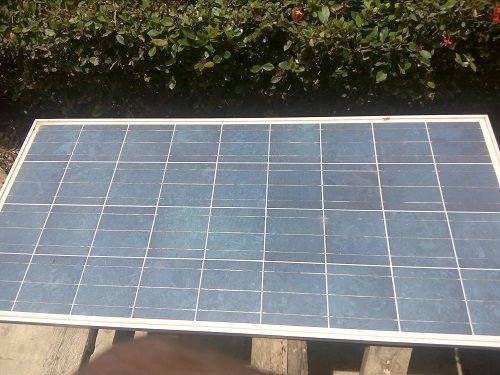PHOTOVOLTAIC EFFECT: HOW SOLAR CELLS ARE MADE
Good day to you great steemians. I have read many posts on solar panels in both steemSTEM and STEMng tags. Most of the post Emphasised mainly on the applications of solar panels which includes: Applications in domestic power supply, solar pump for water supply, power supply for communication systems like mountain top receivers, ocean navigation aids, electric power supply in space, to mention but few. Many of such posts failed to discuss the constituent components, elements or materials that make solar panels to perform their functions. Howbeit, I fount it worthy to intimate you with the details of what solar cells are made up of, thats is exactly what this post will emphasise. Do not confuse a solar cell to solar panel.
Lets add to our knowledge about solar cells
Photovoltaic (PV) effect and photocells

By Rfassbind - Own work, Public Domain, Cycle of Photovoltaic System
Solar energy (energy from the sun) consists of numerous photons which can be made to incident on materials such as some semiconductor material, photovoltaic effect occurs when incident photons(light energy) are made to produce electrical energy in some semiconductors. When this occurs, the resulted device is called solar cell. A photocell is a device that generates or produces a voltage across its terminals when incident energy is made to fall on it, thereby converting the light energy from sun into electrical energy to power home appliances after its being amplified.
Let me quickly tell you that the amount of voltage produced by this photocell is a function of the light intensity, that is, the voltage produced by a photocell increases with increase in the intensity of light energy produced from the sun.
This post will emphasize the solar cell and its constituent that cause it to perform its function. How this solar cell is made will also be discussed. Don't worry, I will make my explanations as explicit as possible.
Let's make some dives !
How solar cell works
Solar cell is a semiconductor device that is likened to a photodiode made from a silicon PN junction. A photodiode detects light energy signal and converts it to an electrical signal causing the current to flow in one direction (just like a common diode). Diode makes the current from the main power supply to charge your phone and never return to the main supply, just like when stream flows in a particular direction and never looks back.

By Gil Knier - Public Domain, How solar cell works
At the P-N junction. there are valence electrons tightly packed to their parent atom. Photons from sunlight are energetic enough to knock out these valence electrons under collision, howbeit, free electrons and holes are produced at the junction. Consequently, current is also produced. Light intensity (illumination) and surface area of illumination are major to the amount of current produced. To ensure that light photons get to the P_N junction easily, the P-type side of the junction is made a tiny layer of P-type semiconductor material on a thicker N-type semiconductor material.
Depending on the intensity of the incident sunlight and the surface area of exposure, electron-holes pairs are produced at the PN junction. Since the PN junction acts like a diode, the free electrons migrate to the n-type side of the junction and never return to the depletion layer and similarly, the holes migrate to the p-type side and never return to the depletion layer, due to the potential barrier at the junction. As concentration of both the free electrons and hole increase, a photo voltage is set up at the p-n junction.
Summary
Photo cell is a device that converts light energy from sunlight intensity to electrical energy. It acts like small battery to power a small load like a light emitting diode (LED) and when many photo cells are concatenated or joined together, solar panels are produced which can power a bigger load. For easy connection and construction, a fixed 0.5 volt solar cell is made.
Types and classifications of Solar cells
Based on the number of solar cell array (interconnection) and desired power output, solar cells are classified as a single solar cell, solar module, and solar array. A single solar cell is made up of the n-type layer embedded or sandwiched with the p-type layer. Its main constituent is from silicon wafer, configured as a wide surface area p-n junction which produces a very small amount of electricity capacity to power various small electronic equipment such a small light bulb, calculators and watches e.t.c.

Image of a Solar module (Image taken by me)
A solar module is made from numbers of interconnected single solar cells usually enbedded in a two glass plate to prevent the cells from damage. The glass plate must be of a non-reflective material. Solar module has a better power specification since its surface area is large enough for better sunlight absorption. The array form of solar cell contains two or more solar modules which could take any form and design depending on the result to be achieved.

Image of a solar array (Image taken by me)
As an example, nowadays, people make solar array part of the roofing design, the number of the solar array to be constructed depends on the power output desired, so instead of buying a full needed roofing sheet for your building, you can decide to make solar panel array a part of the roofing construction, thereby saving cost and also making a gridless power supply for your building.
Solar cells are also classified based on the type of constituent materials. There are many of such solar cells, but before I list the tpypes of solar cells we have, you care to know that the commonly used solar cells are made from silicon crystal material, because silicon is abundantly present, so manufactures prevered to use it. Such solar cells includes: Monocrystalline silicon cells, Polycrystalline silicon cells or Amorphous silicon cells.
The types of solar cells are listed as follows: Amorphous Silicon solar cell (a-Si), Perovskite solar cell, Biohybrid solar cell, Quantum dot solar cell, Concentrated PV cell (CVP and HCVP), Copper indium gallium selenide solar cells (CI(G)S), Crystalline silicon solar cell (c-Si), Multi-junction solar cell (MJ), Dye-sensitized solar cell (DSSC), Hybrid solar cell, Luminescent solar, concentrator cell (LSC), Micromorph (tandem-cell using a-Si/μc-Si), Monocrystalline solar cell (mono-Si), Nanocrystal solar cell, Photoelectrochemical cell (PEC), Plasmonic solar cell, Polycrystalline solar cell (multi-Si), Gallium arsenide germanium solar cell (GaAs), Solid-state solar cell, Thin-film solar cell (TFSC), Cadmium telluride solar cell (CdTe), Organic solar cell (OPV) and Wafer solar cell, or wafer-based solar cell crystalline

By Elvis untot. - Own work., CC BY-SA 3.0,polycrystalline silicon solar cell
Solar cells can be classified also based on the types of sodium crystal used as the constituent material. It can be classified as Monocrystalline silicon cells, Polycrystalline silicon cells or Amorphous silicon cells. Monocrystalline silicon cells are also referred to as single sodium crystal, it is produced from pure and defect free silicon crystal, thereby producing a solar cell with higher efficiency (usually less than 18%).
Conclusion
The surface of all kinds of solar cells must be coated with anti reflection material to prevent the loss of incident sunlight energy caused by reflection. When light photons fall on the semiconductor materials, the valence electrons become energetic enough to promote from valence band to conduction band. The amount of free electrons at the conduction band determings the efficiency of any solar panel system. Solar panel system is reliable and efficient, though it is costly to put in place. Solar cells are fragile, so handle with care.
Thanks for stopping bye
All Images are from free sources
References
https://www.daenotes.com/electronics/industrial-electronics/solar-cell-working-construction
https://www.solargreen.net.au/the-three-types-of-solar-cells.html
https://www.electrical4u.com/solar-cell/
https://www.electrical4u.com/what-is-photovoltaic-effect/
https://en.wikipedia.org/wiki/List_of_types_of_solar_cells
http://energyinformative.org/best-solar-panel-monocrystalline-polycrystalline-thin-film/
Hello. With the growing trend of renewable energy sources its good to be familiarized with their basic principles.

I also want to point out that the license of the second image is not clear. Try to use only images that are free for commercial use.
Thanks for your comment and observation. The image was from a free source labeled for reuse. I go with your kind advice, so changed the image with the one with a clearer license.
Thank you for your contribution and posting your references!
=======================================================================================
This post was upvoted and resteemed by Steemgridcoin with the aim of promoting discussions surrounding Gridcoin and science.
This service is free. You can learn more on how to help here.
Have a nice day. :)
Good work bro.
Thanks for the compliment @conas
Thanks for refreshing my memory... Nice work you did here. The Solar power is gaining waves in recent years... I hope it can be adopted in large scale here in Nigeria at least as an alternative or complement to the existing one...
Well done